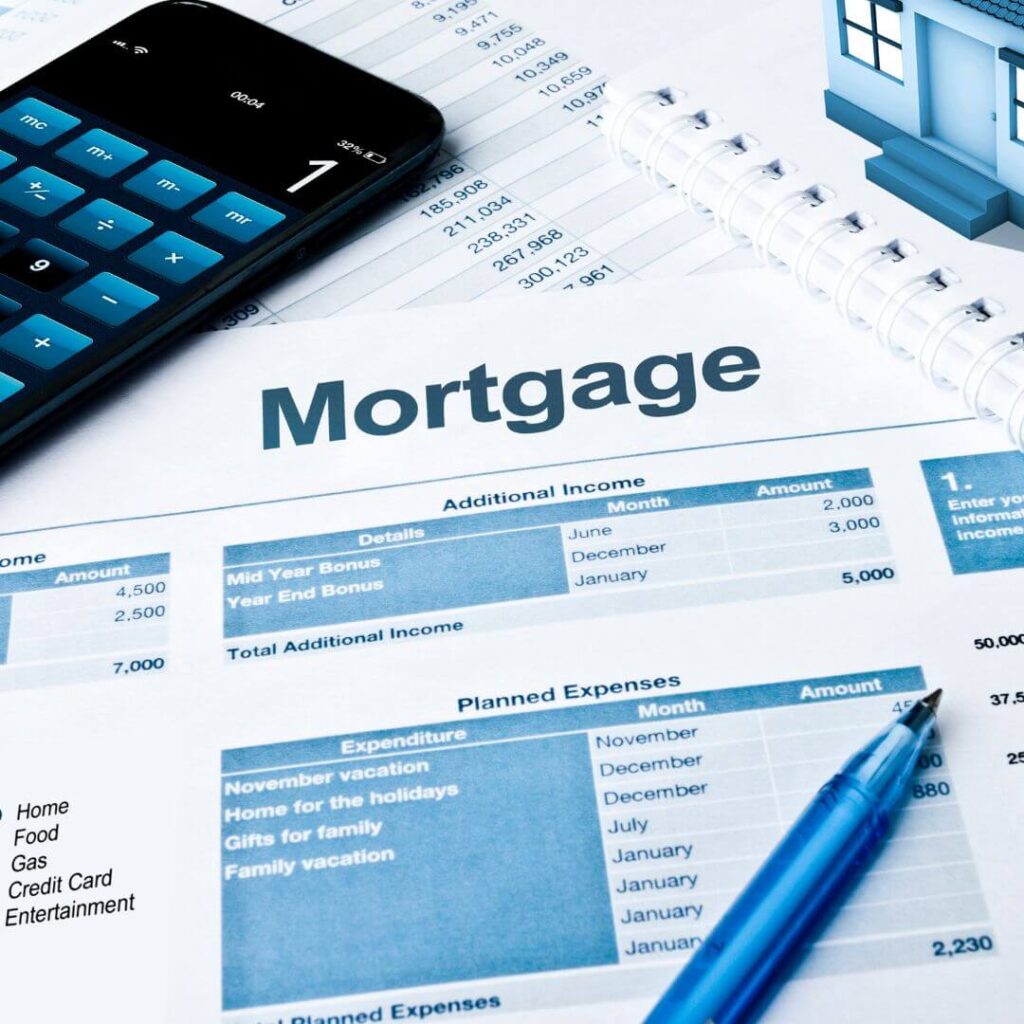Taking out a mortgage is a significant financial decision. Understanding your monthly mortgage payments is crucial to making an informed choice. While using a mortgage calculator is often the preferred method for estimating your monthly payments, it can also be beneficial to have a basic understanding of how mortgage payments are calculated.
This introductory guide will help you navigate the complexities of mortgage payments, including fixed and variable rates and we’ll show you how to calculate mortgage repayments manually.
Arming yourself with the fundamentals of mortgage calculations can be valuable, especially when comparing the various home loan offers on the market. To make sure you’re making the best-informed decision regarding your mortgage and budget we’d always recommend getting professional advice.
Key Takeaways
- Mortgage calculators are useful tools to estimate monthly payments for a home loan.
- Understanding fixed and variable rates is essential when calculating mortgage payments manually.
- The ability to calculate mortgage repayments can aid in making informed financial decisions.
Why is it so complicated?
Mortgage calculations can become complicated because of the ever-changing nature of the numbers involved. When you borrow money, banks charge interest on the loan, which unfortunately can vary over time.
Typically, mortgages use compound interest, so they calculate interest every time you make a payment. This adds another layer of complexity when us mere mortals try to calculate mortgage payments.
Here’s a breakdown to help you understand the main components affecting the complexity:
- Interest rates: The higher the interest rate, the more you’ll pay in interest over the life of the loan. This factor has a significant effect on your overall mortgage cost.
- Fixed-rate mortgage: A fixed-rate mortgage maintains the same interest rate for the entire loan term, such as a 30-year or 15-year fixed-rate mortgage. This makes the calculations slightly easier since the interest rate doesn’t change throughout the loan term.
- Debt-to-Income ratio: This ratio compares your monthly debt payments to your monthly income, affecting how much you can borrow and your ability to repay the mortgage. Lenders, consider your debt-to-income ratio to determine the maximum amount they’re willing to lend you.
- Escrow account: Some mortgage payments include additional components, such as property taxes, homeowners’ insurance, and mortgage insurance (if applicable) bundled into a single payment. They hold these extra costs in an escrow account and paid out as needed, which adds complexity to the mortgage calculation.
Table of components affecting mortgage complexity:
| Component | Impacts |
|---|---|
| Interest rates | Payment, Total cost |
| Fixed-rate mortgage | Stability of rate |
| Debt-to-income ratio | Borrowing amount |
| Escrow account | Simplicity of payments |
- Property tax: This is a tax imposed on your property’s assessed value and can fluctuate based on local tax laws and property value changes. They may include it in your mortgage payment.
- Mortgage insurance: This insurance protects the lender from losses in case you default on the loan. Mortgage insurance adds to the overall cost of your mortgage payment.
- Principal, Interest, Taxes, and Insurance (PITI): These combined components of a mortgage payment can make the calculations challenging, as each element can change over time. Some additional mortgage calculators may come in handy to assist with these calculations.
The complexity of mortgage calculations arises from factors such as interest rates, variable components like property taxes and insurance, and debt-to-income ratios. Try to keep things as simple as possible and start by using our mortgage calculators before seeking guidance from a financial professional.

What about variable rates?
When considering a variable rate mortgage, it’s essential to know that the interest rate can change, often depending on the lender and (for example) the Bank of England’s rate.
Unlike fixed rates, a lender has more control over your interest rate in this scenario.
Predicting interest rates in variable rate mortgages can be challenging. Banks typically offer a “cost for comparison” to give you an idea of the average interest rate you might face if you continue with that mortgage. However, knowing the exact interest rate is often difficult, as it’s hard to predict the future.
It’s crucial to note that most mortgages provide a fixed rate for a short period, usually 2-5 years. Once this introductory period ends, your mortgage will transition to a variable rate. This means your monthly payments may change every month, depending on the adjusted interest rate.
When dealing with an adjustable-rate mortgage or considering refinancing options, it’s essential to weigh the potential risks and benefits of a variable interest rate. Always consider your financial stability and adaptability should things change for the worse before making a decision.
What’s the formula for calculating mortgage payments?
If you’d like to calculate your mortgage payments manually, you can use the following formula. First, gather these values:
- r = Annual interest rate (APRC) divided by 12 months
- P = The loan’s principal (starting balance)
- n = The total number of payments (loan term in years multiplied by 12)
With these values, apply the formula:
M = P * r * (1 + r)^n / ((1 + r)^n – 1)
Using this formula let’s calculate the monthly mortgage repayment for a £420,000 loan at 5.2% interest for 20 years.
Here are the steps to take:
- First, we need to convert the annual interest rate to a monthly interest rate by dividing it by 12.
- So, 5.2% / 12 = 0.004333
- Next, we need to find the number of monthly payments by multiplying the loan term by 12.
- So, 20 * 12 = 240
- Then, we need to plug these values into the formula and simplify it. So, M = 420,000 * 0.004333 * (1 + 0.004333)^240 / ((1 + 0.004333)^240 – 1) = 2,930.64
- And finally, we should round the result to two decimal places. So, the monthly mortgage repayment is £2,930.64
Therefore, if you borrow £420,000 at 5.2% interest for 20 years, you will have to pay £2,930.64 every month for the duration of the loan.
Hopefully, this explains how to calculate mortgage repayments manually. 😉
Calculate Mortgage Repayments Manually
While it may not be as simple as using a mortgage calculator, this method allows you to understand how the values influence your monthly payment.
Remember, this formula doesn’t account for variable rates, which, as we all know, can change over time.
Frequently Asked Questions
What aspects affect my monthly mortgage payments?
Some factors that influence your monthly mortgage payment amount include:
- Principal loan amount
- Interest rate
- Loan term (length of the loan)
- Property taxes
- Homeowners insurance
- Private mortgage insurance (PMI)
Can you walk me through calculating mortgage interest for the entire loan?
Calculating mortgage interest over the life of the loan involves these steps:
- Determine the monthly interest rate (annual interest rate divided by 12)
- Multiply the principal loan amount by the monthly interest rate
- Subtract the interest payment from your monthly payment to find the principal payment
- Update the remaining principal balance
- Repeat steps 2-4 for each month until the loan is fully paid
How does the principal amount affect my mortgage payments?
The principal amount is the initial loan amount borrowed to purchase the home. Throughout the loan term, you’ll make monthly payments that cover both principal and interest.
As you pay down the principal, your interest payments will also decrease, leading to a higher amount of your monthly payment being applied to the principal over time.
What’s a simple way to understand mortgage payment calculations?
We can break mortgage payments down into four main components known as PITI:
- Principal: The portion of the payment that goes toward reducing the principal balance
- Interest: The portion of the payment that goes toward paying the interest on the loan
- Taxes: The portion of the payment that goes toward property taxes
- Insurance: The portion of the payment that goes toward homeowners insurance and, if applicable, private mortgage insurance (PMI)
How can I use an online mortgage calculator to estimate my payments?
To use an online mortgage calculator, just follow these steps:
- Enter the principal loan amount
- Input the loan term (number of years)
- Provide the annual interest rate
- Include any additional fees, such as property taxes, insurance, and PMI (if applicable)
- Click “Calculate” to view the estimated monthly payment
How do I manually calculate my mortgage payments using the formula?
You can compute your mortgage repayments manually using the following formula:
M = P [ i (1 + i)^n ] / [ (1 + i)^n - 1]
Where:
M: Monthly mortgage paymentP: Principal loan amounti: Monthly interest rate (annual rate divided by 12)n: Number of months in the loan term
Input the values into the formula, and it will give you the monthly mortgage payment amount.
